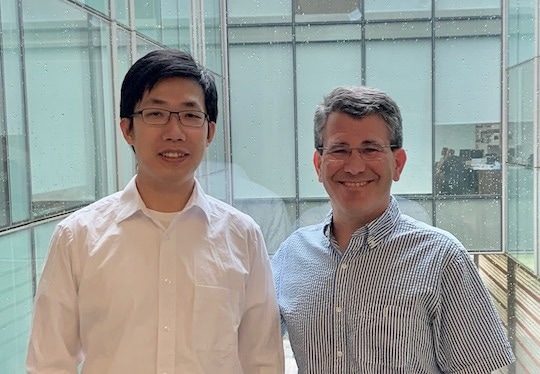In line with expectations, new quantum noise experiments conducted at Rice University revealed an unusually quiet “strange metal” quantum material. The measurements of quantum charge fluctuations, or "shot noise," which were published in Science, offer the first concrete proof that electricity appears to flow through peculiar metals in a peculiar liquid-like form that defies easy explanation in terms of quantized charge packets or quasiparticles.

Physicists Liyang Chen (left) and Doug Natelson. Image Credit: D. Natelson/Rice University
The noise is greatly suppressed compared to ordinary wires. Maybe this is evidence that quasiparticles are not well-defined things or that they are just not there, and charge moves in more complicated ways. We have to find the right vocabulary to talk about how charge can move collectively.
Doug Natelson, Study Corresponding Author and Professor, Rice University
The experiments were conducted on nanoscale wires of a quantum critical material (YbRh2Si2), which is precisely a 1-2-2 ratio of ytterbium, rhodium, and silicon. Silke Paschen, a solid-state physicist at the Vienna University of Technology (TU Wien), has studied this material extensively over the past 20 years.
High levels of quantum entanglement in the material result in a very peculiar (or “strange”) temperature-dependent behavior that differs greatly from that of common metals like silver or gold.
Each discrete unit of charge, or quasiparticle, in such typical metal is the result of many electrons interacting in imperceptibly small ways. For the sake of quantum mechanical computations, physicists employ the quasiparticle notion, first proposed 67 years ago, to represent the total effect of all those interactions as a single quantum item.
A previous theoretical study had suggested that such quasiparticles might not carry the charge in a strange metal and shot noise experiments allowed Natelson, Liyang Chen, a former student in Natelson’s lab, and other co-authors from Rice and TU Wien to collect the first direct empirical evidence to test the theory.
Natelson added, “The shot noise measurement is basically a way of seeing how granular the charge is as it goes through something. The idea is that if I am driving a current, it consists of a bunch of discrete charge carriers. Those arrive at an average rate, but sometimes they happen to be closer together in time, and sometimes they are farther apart.”
Significant technical obstacles were encountered when using the procedure in YbRh2Si2 crystals. Shot noise investigations require samples that are nanoscopic in size rather than single macroscopic crystals.
Consequently, it was necessary to grow incredibly thin but flawlessly crystalline films, which Silke Paschen, Maxwell Andrews, and their associates at TU Wien accomplished after nearly ten years of arduous struggle. Chen then had to figure out how to make wires out of these thin films, which were roughly 5,000 times thinner than human hair, while keeping that degree of precision.
The study’s lead theorist and co-author at Rice, Qimiao Si, stated that in 2016, during Paschen's visit as a visiting researcher, he, Natelson, and Paschen originally explored the idea for the experiments. According to Si, the findings align with a theory of quantum criticality he first presented in 2001 and has since pursued in his nearly twenty-year partnership with Paschen.
The low shot noise brought about fresh new insights into how the charge-current carriers entwine with the other agents of the quantum criticality that underlies the strange metallicity. In this theory of quantum criticality, the electrons are pushed to the verge of localization, and the quasiparticles are lost everywhere on the Fermi surface.
Qimiao Si, Study Lead Theorist, Harry C. and Olga K. Wiess Professor, Physics and Astronomy, Rice University
According to Natelson, the more significant inquiry is whether any or all of the dozens of additional compounds that have peculiar metal activity might display a similar behavior.
“Sometimes, you kind of feel like nature is telling you something. This ‘strange metallicity’ shows up in many different physical systems, despite the fact that the microscopic, underlying physics is very different. In copper-oxide superconductors, for example, the microscopic physics is very, very different than in the heavy-fermion system we’re looking at. They all seem to have this linear-in-temperature resistivity that’s characteristic of strange metals, and you have to wonder if there is something generic going on that is independent of whatever the microscopic building blocks are inside them,” Natelson added.
The study was funded by the following organizations: the Department of Energy’s Basic Energy Sciences program (DE-FG02-06ER46337), the National Science Foundation (1704264, 2220603), the European Research Council (101055088), the Austrian Science Fund (FWF I4047, FWF SFB F 86), the Austrian Research Promotion Agency (FFG 2156529, FFG 883941), the European Union’s Horizon 2020 program (824109-EMP), the Air Force Office of Scientific Research (FA8665-22-1-7170), the Welch Foundation (C-1411) and the Vannevar Bush Faculty Fellowship (ONR-VB N00014-23-1-2870).
Journal Reference
Chen, L., et al. (2023) Shot noise in a strange metal. Science. doi:10.1126/science.abq6100.
Article Revisions
- Jan 6 2025 - Meta Description has been updated to fall inline with Google recommendations and a malformed link has been repaired.